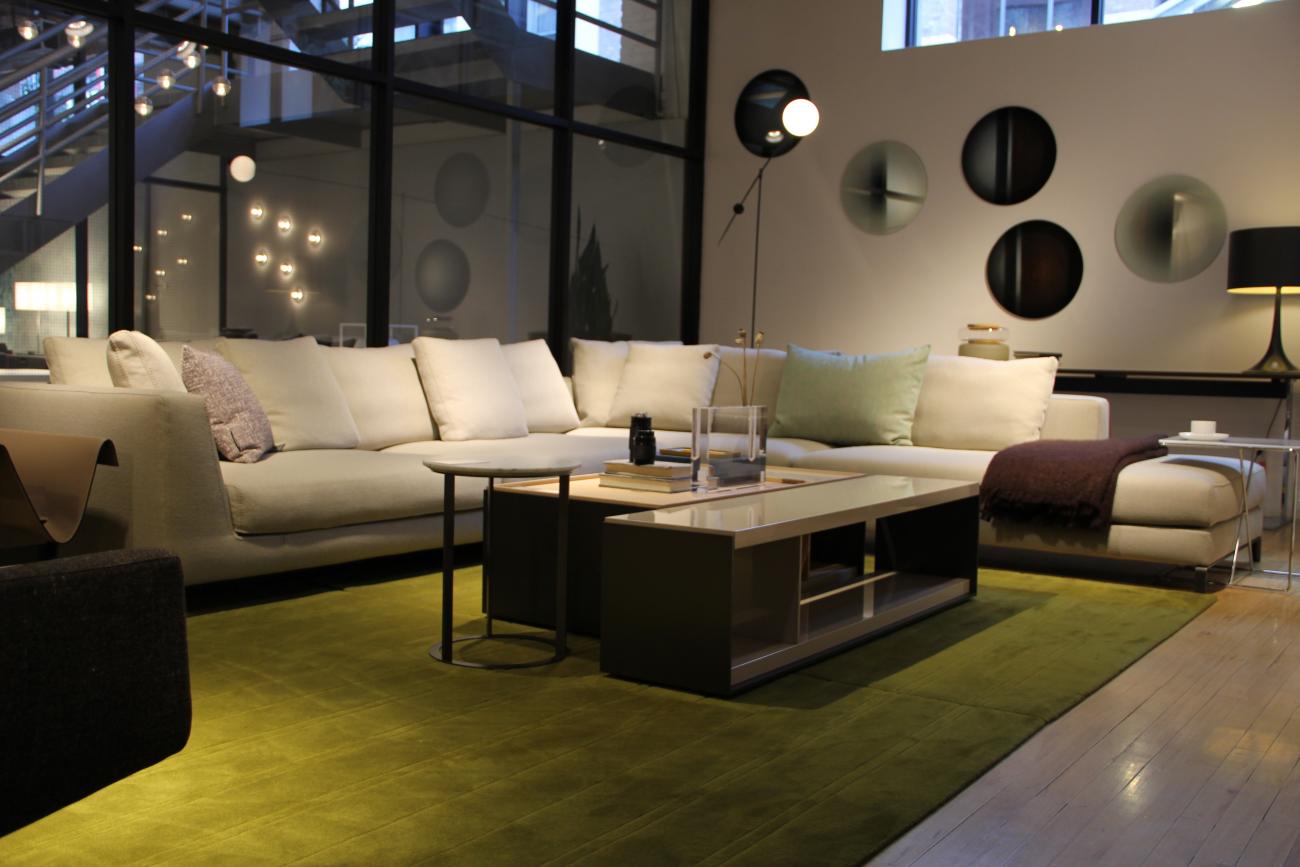The first stop on our road trip is Lighting & Decor’s hometown, Chicago. Home to Willis Tower, deep dish pizza and Al Capone, Windy City showrooms have their work cut out for them. Here’s how Luminaire and Hortons Home Lighting are meeting the challenge.
Luminaire

High above the corner of Franklin Street and Superior Street, a brown line train rumbles down the El tracks, heading for the Loop. The sound eclipses conversations, barking dogs and even ambulance wails, but inside the Luminaire showroom, the rumble feels like part of the music.
With three levels and 21,000 square feet, Luminaire has been a River North institution since 1989. The neighborhood boasts the largest concentration of art galleries outside of Manhattan, and inside the showroom, furniture creates scenes that could be backdrops for realist paintings.
“It’s almost like creating more of a gallery quality as well as letting you know that yes you can come in and these things are for your home too,” says store manager Scott Davis.
Davis came to Luminaire a year and a half ago, and he manages a team of 15 people. Nasir Kassamali and his wife, Nargis, who immigrated to the United States in 1973, own the showroom. Inspired by artists such as Mies van der Rohe, Alvar Aalto and Arne Jacobsen, the Kassamalis opened their first showroom in 1974. It was a 500-square-foot kiosk located in North Miami Beach, and it sold mainly European lighting. Two years later, the business moved to a 4,500-square-foot showroom and then moved again in 1984 to Coral Gables. The Chicago showroom followed five years later.
Kassamali continues to travel the world, talking with manufacturers and designers. He believes your environment is your third skin — the first being your physical skin and clothes the second. He aims to help people find the right piece for their skin.
Luminaire caters best to those who love design — art lovers, design fanatics, anyone who’s curious about finding something unexpected and new. Wanderers through River North’s many art galleries will often stop in to admire the showroom’s clean lines and minimalist designs.
“People come in off the street because it catches them,” Davis says. “Even if they don’t know or aren’t an experienced designer, they come in and we show them around and educate them.”
The showroom keeps few things in stock. Most of the furniture can be customized to fit different-sized spaces, and clients can choose from an array of upholstery styles. Davis says the Mid-Century Modern craze continues in Chicago, and now that younger people are buying homes, they’re wanting a deviation from what their parents had.
Although Luminaire doesn’t directly compete with all online retailers, some are still a concern for Davis. His clients aren’t the type to purchase a couch or bed sight unseen, but they’re willing to buy light fixtures and small tables online. Luminaire sells only its smaller items on its website, so it isn’t undercutting the personal approach of its showrooms.
“That’s why you don’t see us selling sofas on [our website],” Davis explains. “It’s more accessory-oriented.”
Even as styles and shopping change, Davis feels confident that one thing will remain the same in the showroom: great design.
“Design really is for everyone,” he says. “Sometimes it seems like it’s very much becoming the new art in a certain sense. There’s a nice bridge between art and design, but design even then has to be functional. You have to use it to better our lives — that’s one of the factors.”
Hortons Home Lighting
One can still smell the fresh paint at Hortons Home Lighting in Chicago. The location, which is comparatively young considering the age of the company, looks bright and clean when peeking through the showroom’s window in the city’s Lincoln Park neighborhood — almost as bright as the disco ball-style fixture hanging near the main desk.
In La Grange, IL, Hortons Home Lighting has been providing residents with a lighting selection from around the world for nearly a century. Though its Lincoln Park and La Grange stores are 20 miles apart, this store on Clybourn Avenue still attracts many of those same clients from La Grange – only now they’re empty nesters living in the city.
“We want to be on trend with an urban feel showing popular looks and an expanded display of contemporary lighting,” owner John Rot says.
Founded in 1896 by Richard Horton, Hortons began as an electrical contracting business in La Grange. Horton retired in 1930 and sold the business to the McClain family. They expanded the business to include lighting fixtures and electrical supplies in 1938. Almost 50 years later, the company was purchased again and expanded once more — it now offers kitchen, bath, furniture and accessory products, plus has a sister hardware store.
Rot and his then-partner bought Hortons in 1995. The second Orland Park location opened in March 1996, and the Lincoln Park location opened in November 2007.
Without good merchandising, lighting showrooms can look cluttered and confusing — an effective design that moves the customer naturally through the store is key. At Hortons, vignettes mix styles of lighting fixtures of the same aesthetic together. Rot’s merchandising strategy consists of organizing the showroom into areas focused on style, finish, trend or category. In the far back, for example, rustic fixtures hang from the ceiling.
“We believe this makes it easier to shop for our clients looking for particular needs,” Rot explains.
Clients do influence product choices, and Rot says most of their lighting selection comes from Lightovation. He and his team attend the January and June markets to find new styles and give the showroom a fresh look.
The future of Hortons truly depends on the showroom’s ability to keep up with the latest technology. Now that light bulbs can be controlled with apps and lamps can order pizzas, Rot believes the company has its work cut out for it.
“Our clientele is very well-informed,” Rot says, “and our staff must stay two steps ahead of them concerning latest technology trends, especially with LEDs and controls. We work hard to keep our Lighting Specialists up-to-date with these technologies.”
At the core of Hortons, family has always been a priority. In 2001, two employees and friends passed away from cancer. To honor their memory, Hortons started the H Foundation, which raises money for cancer research and puts on its annual Goombay Bash fundraiser in July.
“As of today,” Rot says, “the H Foundation has raised over $7 million for cancer research. Many of our employees volunteer year-round to raise money for the foundation.”
Hortons’ dedicated staff never shies away from change, and as the company and its market evolve, they’re ready to meet challenges head on.
Next stop...
Boston! Keep an eye out for the best in Beantown and its surrounding areas coming up in July.







